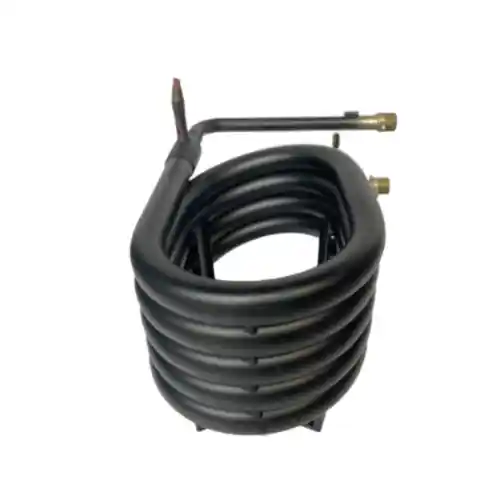1. Introduction
Aluminum tubes have gained significant popularity in the field of coaxial heat exchangers due to their unique characteristics and advantages. This article delves into the properties of aluminum tubes, their suitability for various applications, and compares them with other materials commonly used in heat exchangers. We will explore the different types of aluminum tubes, their thermal conductivity, corrosion resistance, and their impact on the overall performance of coaxial heat exchangers.
2. Types of Aluminum Tubes for Coaxial Heat Exchangers
2.1 6061 Aluminum Tubes
6061 aluminum tubes are one of the most widely used types of aluminum in heat exchanger applications. These tubes exhibit excellent corrosion resistance, high strength, and good formability. The following table provides a comparison of the composition and properties of 6061 aluminum tubes:
| Aluminum Grade | Composition (%) | Tensile Strength (MPa) | Yield Strength (MPa) | Thermal Conductivity (W/m·K) |
|---|---|---|---|---|
| 6061 | Al (97.9%), Mg (1%), Si (0.6%), Cu (0.28%) | 310 | 275 | 167 |
2.2 1100 Aluminum Tubes
1100 aluminum tubes are commercially pure aluminum tubes with excellent corrosion resistance and high thermal conductivity. They are commonly used in applications where high heat transfer efficiency is crucial. The following table compares the composition and properties of 1100 aluminum tubes:
| Aluminum Grade | Composition (%) | Tensile Strength (MPa) | Yield Strength (MPa) | Thermal Conductivity (W/m·K) |
|---|---|---|---|---|
| 1100 | Al (99.6% min) | 105 | 75 | 237 |
2.3 3003 Aluminum Tubes
3003 aluminum tubes offer good corrosion resistance and moderate strength. They are often utilized in applications where formability and weldability are essential. The following table presents a comparison of the composition and properties of 3003 aluminum tubes:
| Aluminum Grade | Composition (%) | Tensile Strength (MPa) | Yield Strength (MPa) | Thermal Conductivity (W/m·K) |
|---|---|---|---|---|
| 3003 | Al (98.6%), Mn (1.2%) | 130 | 115 | 167 |
3. Advantages of Aluminum Tubes in Coaxial Heat Exchangers
3.1 Thermal Conductivity
Aluminum tubes exhibit high thermal conductivity, allowing for efficient heat transfer in coaxial heat exchangers. The excellent heat transfer properties of aluminum contribute to improved performance and energy efficiency.
3.2 Corrosion Resistance
Aluminum tubes possess inherent corrosion resistance, particularly in environments with low pH levels. However, in certain aggressive environments, such as highly acidic or alkaline conditions, aluminum may require additional protective measures.
3.3 Lightweight Construction
One of the key advantages of aluminum tubes is their lightweight nature. Aluminum is significantly lighter than other common materials used in heat exchangers, such as copper or stainless steel. This weight advantage is particularly important in applications where weight reduction is a critical factor, such as aerospace or automotive industries.
3.4 Cost-Effectiveness
Aluminum tubes are relatively cost-effective compared to other materials. The abundance of aluminum as a raw material, coupled with its ease of fabrication, contributes to its cost advantage in heat exchanger applications.
4. Comparison with Other Materials
4.1 Copper Tubes
Copper tubes are widely used in heat exchangers due to their excellent thermal conductivity and corrosion resistance. However, copper is heavier and more expensive compared to aluminum. The table below highlights the comparison between copper and aluminum tubes:
| Material | Corrosion Resistance | Strength | Thermal Conductivity (W/m·K) | Weight (g/cm³) |
|---|---|---|---|---|
| Cobre | Excellent | Moderate | 385 | 8.96 |
| Aluminum | Good | Moderate | 167-237 | 2.70 |
4.2 Stainless Steel Tubes
Stainless steel tubes are known for their superior corrosion resistance and strength. However, they have lower thermal conductivity compared to aluminum. The following table presents a comparison between stainless steel and aluminum tubes:
| Material | Corrosion Resistance | Strength | Thermal Conductivity (W/m·K) | Weight (g/cm³) |
|---|---|---|---|---|
| Acero inoxidable | Excellent | High | 16.3 | 7.93 |
| Aluminum | Good | Moderate | 167-237 | 2.70 |
5. Applications of Aluminum Tubes in Coaxial Heat Exchangers
Aluminum tubes find extensive applications in various industries where lightweight construction, thermal efficiency, and cost-effectiveness are key factors. Some notable applications include:
5.1 HVAC Systems
Coaxial heat exchangers with aluminum tubes are commonly used in heating, ventilation, and air conditioning (HVAC) systems. The lightweight nature of aluminum contributes to reduced energy consumption and enhanced system performance.
5.2 Automotive Industry
Aluminum tubes are utilized in automotive heat exchangers, such as radiators and intercoolers. Their lightweight properties help improve fuel efficiency and overall vehicle performance.
5.3 Renewable Energy Systems
Aluminum tubes are suitable for heat exchangers used in renewable energy systems, including solar thermal systems and geothermal heat pumps. Their thermal conductivity and corrosion resistance make them ideal for transferring and exchanging heat in these applications.
6. Conclusion
Aluminum tubes offer numerous advantages in coaxial heat exchangers, including high thermal conductivity, corrosion resistance, lightweight construction, and cost-effectiveness. Various grades of aluminum, such as 6061, 1100, and 3003, provide options to cater to specific application requirements. When compared to other materials like copper and stainless steel, aluminum tubes showcase their unique benefits, making them suitable for applications in HVAC systems, automotive industry, renewable energy systems, and more. By leveraging the advantages of aluminum tubes, engineers and designers can enhance the performance and efficiency of coaxial heat exchangers in various industrial sectors.


